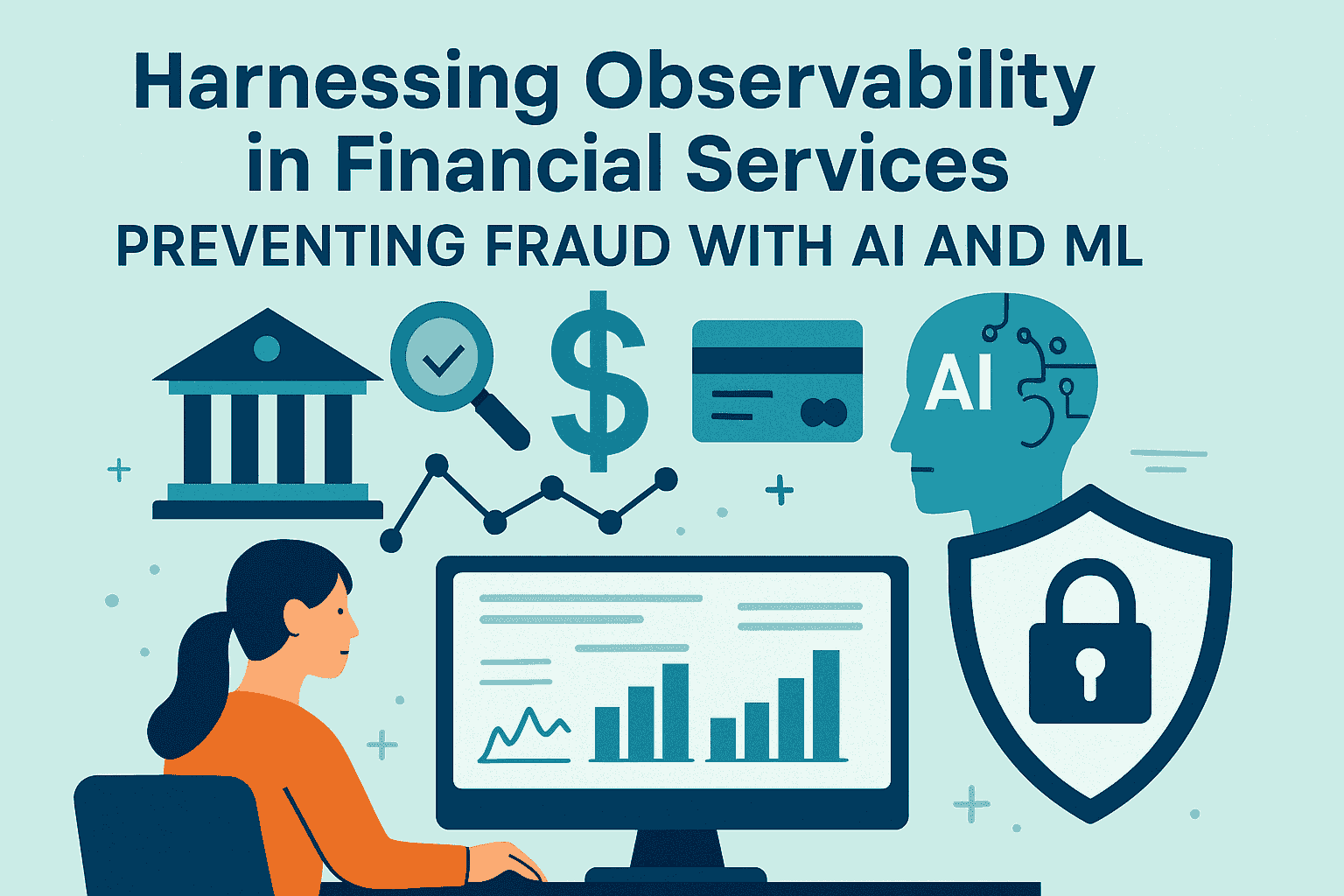Harnessing Observability in Financial Services: Preventing Fraud with AI and ML

Description: In an era defined by digital transactions and real-time banking, the ability to observe, monitor, and understand every layer of your financial systems is critical. By combining robust observability practices with cutting-edge AI and ML techniques, banks and payment processors can detect anomalies, anticipate threats, and stop fraud before it impacts customers or reputation.
Introduction
The finance sector—encompassing retail banking, investment services, and payment processing—is under constant pressure to scale, innovate, and secure billions of daily transactions. Unfortunately, as digital channels proliferate, so do sophisticated fraud schemes. Traditional reactive approaches to security—investigating once fraud has occurred—are no longer sufficient. Instead, leading institutions are adopting observability: the practice of instrumenting systems to generate rich telemetry (logs, metrics, traces) and using that data to gain real-time insights into system behavior. When layered with artificial intelligence (AI) and machine learning (ML), observability transforms from passive monitoring into a proactive shield against malicious activity.
What Is Observability—And Why Does It Matter in Finance?
At its core, observability is about asking: “Given everything we can see (telemetry), what can we infer about the hidden state of our systems?” For banks and payment platforms, observability provides:
- Comprehensive Visibility: Capturing every API call, database query, and transaction flow to construct an end-to-end picture of user and system behavior.
- Real-Time Alerting: Defining Service Level Objectives (SLOs) and triggering alerts whenever latency, error rates, or throughput deviate from normal patterns.
- Rapid Forensics: Tracing the lineage of a suspicious transaction—down to individual microservices or network hops—so teams can isolate vulnerabilities.
This level of transparency is crucial when financial operations are distributed across cloud services, on-premises data centers, and edge devices. Without observability, anomalies that indicate fraud—such as unusually large transfers, rapid-fire payment attempts, or strange login patterns—can slip through the cracks until it’s too late.
The Observability Stack: Building Blocks for Fraud Prevention
A robust observability platform typically consists of three pillars:
- Metrics: Quantitative measurements (e.g., number of transactions per second, queue depths, CPU usage) that reveal system health at a glance.
- Logs: Detailed, timestamped records (e.g., user actions, authorization checks, error messages) that provide context for diagnosing issues.
- Traces: Distributed tracing links requests across services, exposing the path and latency of each transaction, crucial for spotting bottlenecks and suspicious detours.
Together, these pillars feed a centralized observability backend—often powered by open-source tools like Prometheus, Jaeger, or commercial offerings such as Datadog or New Relic. But raw data alone isn’t enough. This is where AI and ML enter the picture.
AI and ML: From Detection to Prediction
Anomaly Detection at Scale:
ML models can continuously learn normal transaction patterns—account balance changes, login locations, device fingerprints—and flag deviations in milliseconds. Unsupervised algorithms (e.g., clustering, autoencoders) excel at uncovering previously unseen fraud tactics without requiring labeled data.
Risk Scoring with Supervised Learning:
By training on historical fraud cases, supervised classifiers (e.g., Random Forests, Gradient Boosting Machines) assign risk scores to incoming transactions. High-risk payments trigger step-up authentication or manual review, while low-risk transactions proceed seamlessly—balancing security and user experience.
Predictive Monitoring:
Observability data streams can feed time-series forecasting models that predict spikes in fraudulent activity—perhaps coinciding with holidays or major events. Operations teams use these forecasts to pre-position resources, adjust SLO thresholds, and tighten security controls proactively.
Feedback Loops for Continuous Improvement:
As AI models surface alerts, security analysts validate and label outcomes (true fraud or benign anomaly). This feedback enriches training datasets, continuously refining model accuracy and reducing false positives.
Putting It All Together: A Fraud Prevention Workflow
- Instrumentation: Every application and microservice emits standardized telemetry via agents or SDKs.
- Aggregation: A central observability platform ingests, stores, and indexes logs, metrics, and traces in real time.
- Feature Extraction: ML pipelines transform raw telemetry into features—e.g., transaction velocity, IP geolocation variance, API error patterns.
- Model Inference: Pre-trained AI models evaluate each transaction, producing risk scores or anomaly flags.
- Automated Response: High-risk events invoke playbooks—blocking transactions, challenging for multi-factor authentication, or escalating to fraud teams.
- Human Review & Feedback: Security analysts verify alerts, annotate outcomes, and feed this information back into model training cycles.
Real-World Impact
Several leading banks and fintechs have reported dramatic improvements:
- Reduced Fraud Losses by up to 60%: Early anomaly detection enabled swift containment of fraudulent transfers.
- 80% Fewer False Positives: Advanced risk scoring ensured genuine customers faced minimal friction.
- 30% Faster Incident Response: Distributed tracing cut investigation times from hours to minutes.
These results underscore how observability coupled with AI/ML not only thwarts existing fraud schemes but also hardens defenses against emerging threats.
Best Practices for Implementation
- Start with High-Value Transactions: Prioritize observability on systems handling large transfers, cross-border payments, and API endpoints.
- Standardize Telemetry Formats: Adopt OpenTelemetry to ensure consistency across polyglot environments.
- Invest in Data Quality: Clean, enriched data yields better AI performance—use data validation and enrichment services (e.g., IP geolocation, device fingerprinting).
- Govern AI Ethically: Implement explainability tools (SHAP, LIME) so analysts understand why a transaction was flagged.
- Foster Collaboration: Break down silos between DevOps, Security, and Data Science teams to share insights and feedback rapidly.
Conclusion
At NovusCode, we understand that in today’s fast-paced financial landscape, staying ahead of fraud is not just a priority—it’s a necessity. Our comprehensive observability solutions, powered by cutting-edge AI and machine learning, deliver real-time insights, proactive threat detection, and automated responses that safeguard your banking and payment systems before issues arise. Partner with NovusCode to fortify your operations, enhance customer trust, and achieve peace of mind knowing your financial services are protected by the best in the industry. Connect with us today to discover how we can tailor our observability and AI/ML expertise to meet your unique security needs.


